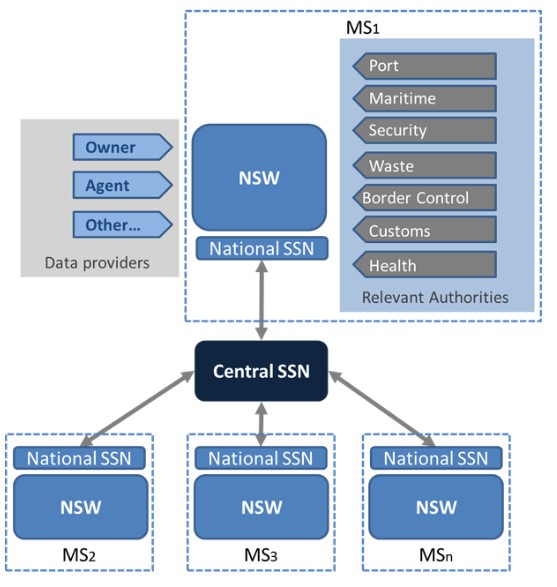
As members of the European Union, countries like Belgium, the Netherlands, and France must comply with new directives and regulations imposed by the EU. One such regulation revolving around the maritime sphere called the “European Maritime Single Window environment (EMSWe)” must be implemented by all member states to ease administrative processes for vessels while entering, staying at, and leaving a port.
My name is Morgan Michaux, a 27-year-old Belgian International Business student pursuing a double degree at Satakunta University of Applied Sciences (SAMK). To fulfil the requirements of this program, I completed an internship at SAMK, Maritime Logistics Research Center. My internship focused on researching the implementation of the European Maritime Single Window in Belgium, the Netherlands, and France.
The European Maritime Single Window environment (EMSWe) is a regulation imposed on all EU members. The reason why only these three countries were selected is that I am a Belgian citizen and proficient in French, English, and Dutch. This allows me to access information more easily than those fluent only in English.
My task consisted of analysing every document and piece of information I could find concerning the implementation of the EMSWe in the three aforementioned countries. All member states must implement the new regulation, but each country can choose how to achieve this objective, and they do not all proceed at the same speed.
What is the EMSWe?
The European Maritime Single Window environment (EMSWe) is an EU initiative aimed at creating a unified platform where all member states share data on vessels entering and leaving their ports.
The new regulation replaces the outdated Reporting Formalities Directive (RFD) of 2010. Like its predecessor, the European Maritime Single Window (EMSWe) aims to streamline administrative processes. By harmonizing required documentation, ship owners, operators, or agents need only submit reports once. The EMSWe and National Single Windows then share this information with relevant authorities.

The functioning of the EMSWe is illustrated in Figure 1. Upon arriving or departing a port, ships must submit information to the Port Community System (PCS). The PCS then shares this data with the National Single Window (NSW), which subsequently transmits the data to relevant authorities. The NSW also communicates with SafeSeaNet (SSN), the single window mandated for all EU member states. For instance, a vessel entering into a Belgian port reports to the Belgian PCS, which forwards data to the Belgian NSW and ultimately to SSN. If the same vessel departs for a Dutch port, SSN transfer the data to the relevant Dutch authorities, ensuring a pre-arrival knowledge of the vessel.
Implementation of the EMSWe in Belgium, The Netherland and France
The task assigned to me seemed simple, but turned out to be more difficult than expected. This difficulty was due to a lack of information. Sometimes, information was easy to find, but often, one piece of information could only be found or understood correctly by combining multiple sources. Sometimes, even luck played a role in finding the information I needed. For example, while researching Belgium, I could not find information on the Belgian National Single Window. It was two weeks later, while researching the Netherlands, that I managed to find information on the Belgian NSW called SafeSeaBEL, referencing SafeSeaNet.
Belgium was the most challenging country in terms of finding information. In fact, there is still some missing information preventing me from fully understanding the progress of Belgium’s implementation of the EMSWe. I even sent an email to the Belgian authorities, but I never received a response. I conclude that there are two possible outcomes: either Belgium has not yet started implementing the EMSWe, or Belgium has already completed its implementation. I arrived at the second conclusion because, despite an official website that has not been updated since before the new European directive, it seems that they already have a functioning reporting system connected to SafeSeaNet.
The Netherlands, on the other hand, was the easiest country in terms of finding information. My conclusion concerning this country is that they are ready to implement the EMSWe. The Dutch have created a Port Community System applicable to all ports in the country, while in Belgium, each port has its own PCS. The Dutch also have a National Single Window that applies to air freight as well. This NSW reports to SSN.
France, in terms of research, was positioned between Belgium and the Netherlands. My conclusion regarding France is that they should be ready to implement the EMSWe on time. The latest information I found dates from 2022, but at that time, they seemed confident in achieving their goal on time. Moreover, they already used some sort of National Single Window in the past, which they will replace with a more recent one that complies with the European directive. France’s system is a combination of the Belgian and Dutch systems. France has a total of seven PCS for over fifty ports, and all of them will report to the French National Single Window, which will transfer data to the European SSN.
The training results will be used in NEMO CEF project to mirror processes of the European Maritime Single Window Environment in Finland. The training was completed during summertime 2024. It consisted of individual work, e-mails, and several online meetings. The training process was smooth for me, Morgan as a student and to supervisors at Maritime Logistics Research Center at SAMK.
Text: Michaux Morgan, Markku Hänninen, Minna M. Keinänen-Toivola
Photo: Michaux Morgan
Reference